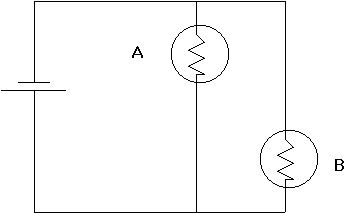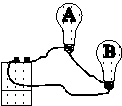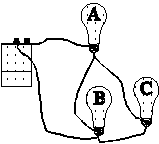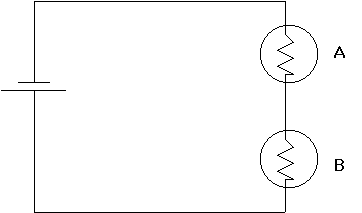|
|
|
 |
|
|
System 2 |
All four bulbs are identical and have resistance R. The two batteries
are identical and produce an EMF = E. Answer
the following questions and explain why you believe your answer.
(a) In system 1, which bulb is brighter?
(b) In system 1, what is the current through each bulb, the voltage drop
across each bulb, and the power dissipated by each bulb?
(c) In system 2, which bulb is brighter?
(d) In system 2, what is the current through each bulb, the voltage drop
across each bulb, and the power dissipated by each bulb?
(e) Which bulbs are brighter, those in system 1 or those in system 2?
(f) If one bulb in each system burns out, will the other go out as well?
Why? If the other bulb doesn't burn out will it get brighter or stay the
same?
2) In the three pictures below are shown some bulbs and batteries connected
together in different ways. The bulbs are all identical. For each case,
give the letter that tells which of the bulbs will be brighter. If two
or more will be equal in brightness, give the letters of all the bulbs
which will be of the greatest brightness.
 |
 |
 |
| Case 2.1 |
Case 2.2 |
Case 2.3 |
3) (a) All of the bulbs in Figure 1 have the same resistance R. If bulb
B is removed from the circuit, what happens to the current through bulb
A, bulb D, and the battery? Indicate whether it increases, decreases or
remains the same. For each case, explain your reasoning.
(b) A wire is added to the circuit as shown in Figure 2. What happens to
the current through bulb A, bulb D, and the battery? Indicate whether each
increases, decreases, or remains the same. For each case, explain your
reasoning.
(c) What is the total resistance of the network shown in Figure 3? Again,
all of the bulbs have the same resistance R.
(d) If the current through the bulb on the right is I as indicated, what
is the current through each bulb and through the battery?
 |
 |
 |
| Figure 1 |
Figure 2 |
Figure 3 |
|










![]()